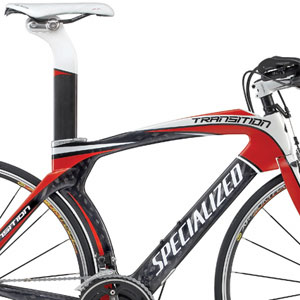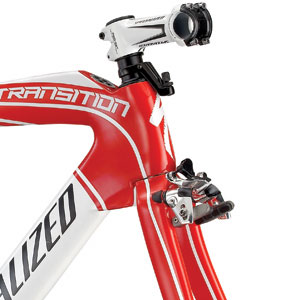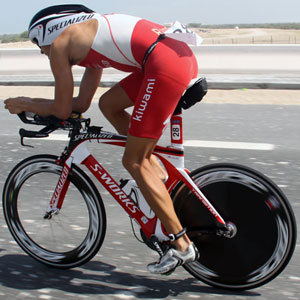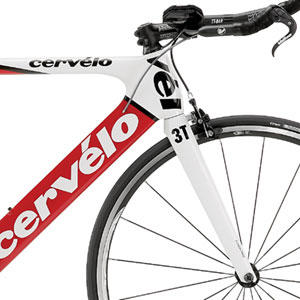
This is the bike Spartacus rides. With different parts.
The $2800 complete bike Transition Comp sports a slightly different set of frame materials inside of the otherwise identical frame mold than does the bike ridden by Fabian Cancellara, Chris McCormack, and other professionals. That's the other difference between this bike and theirs.
Not that this ever makes very much difference, but, you never know, do you, in the back of your mind, whether (in these one-mold/different-weave models) the hi-mod, triple-X mega-composite weave, is superior to the hi-mod, double-X mega-composite weave?
Rappstar rides the Transition as well and, though he's very happy with the bike, he notes it's stiff—very stiff. This might be important to a guy like Cancellara, but, Spartacus doesn't contest Ironmans, nor does he train on his Transition as much as you would train on yours. So, maybe the "lesser" Transition Comp is a better bike for you than the bike costing four times as much.
Thank you Specialized for allowing a rider to put his saddle where he wants it. [Digression] Here's a secret for all you bike designers out there: When you allow a rider input on his own position—when a fit session includes actually asking the rider whether he's comfortable and powerful—the rider, when given a legitimate, well-executed, choice in positions, will choose 79.5° of seat angle. This is the average. This is where the fat of the bell curve sits. [/Digression] So...
Here's a bike company that made a timed race bike to help in its quest for that elusive yellow jersey, nevertheless it thought enough about this bike's target market to allow customers the sit where they want. This, because the Transition Comp—and all the Transitions—come with one of three available seatposts.

The seatposts are named Team (way set back, without very much difference between it's two fore and aft positions); the Regular post; and the Straight post. These posts are each two-position posts, and, on the straight post, the center of the binder mechanism sits either 100mm behind the BB or 150mm behind the BB depending on whether the binder mechanism is in its fore or aft position.
The offsets are rational and thought-out. The swept back post (Regular post) has offsets of 160mm and 210mm. The Team post has offsets of 200mm and 225mm respectively.
Your safest bet is to get your Transition with a Straight post (you may well choose the rear position of the Straight post). But if you're a taller rider—riding the XL or XXL—you might need the Regular post, with the moderate backsweep. This, because the seatpost sticks straight up, at 90°, so, the taller the bike size, the nominally steeper the bike is already.
Not to beat on this subject too hard, but [Digression back on], how difficult is it to do what Specialized has done? Why can't bike companies who seek to sell to triathletes just take a digital level, pass it through both the bottom bracket and the center of the saddle's rails as the saddle is pushed all the way forward, and see if the first number is 8. It can be 80°, 80.5°, 82°, but, the first number needs to be 8.
It needs to be 8 as the saddle sits at a representative height from the pedals in each size, that is, it needs to adjust forward to 80° or steeper in the smallest size (when the top of the saddle sits 67cm from the bottom bracket axle), and in the largest size, when the saddle sits 85cm from the BB axle (and for every saddle height in between). Note to product manager (or engineer, or bike designer): if the first number on your digital level is a 7, go back to the drawing board. Literally. You can figure this out in SolidWorks, or, using a little junior class trig. This will save the trouble of wondering whether your design gets riders steep enough.
[/Rant]

The Transition Comp features a set of center pull brake calipers that go with this bike—they can't be changed out. This, because it's essential to the bike's aerodynamics to get the brake cables out of the way, and, to get the rear brake down by the bottom bracket, instead of in its traditional place behind the seat cluster. (The next couple of pics show some of these frame features, but, with a frame that's got a different color scheme than the Transition Comp. Refer to the pic at the top of this article for a look at the colorways of this Specialized model).
About these brake calipers: They can be a bitch to center, and to get each caliper arm to pull with equal force and throw upon compression. This, unless you disassemble the brakes and grease the holy spit out of them. Then, reassemble and they'll function quite nicely. They have a spreading mechanism for wheel entry/exit, and a barrel adjuster to adjust cable tension.
This center pull brake requires a set of cable stops, front and rear, and, in the case of the front, it's a ring that sits on the steer column. This ring takes up space, that is, if you can't get the front of your transition low enough, the ring takes up the space of a 10mm spacer. This makes the distance between the stem and the head tube top 15mm or greater. You can't have less than 15mm: 10mm for the cable stop thingy, and 5mm for the headset top cap. But, Specialized does make a piece that's a headset top cap and cable stop all in one. The total height of this piece is 5mm. So, if you need that extra 10mm of "lowness" you can get it, but (in a Jack Nicholson voice), You have to ask nicely. The part doesn't come original equipment.

As you know, around here we think the models we review ought to perform all the basic functions of a bicycle. We're picky that way. The Transition is one that does. This includes fit and handling. The bike is a middlin' in terms of its geometry, not as "long and low" as a Cervelo or Felt, less "narrow and tall" as a Scott Plasma. It'll fit a lot of folks reasonably well. In the context of a size run, the six sizes available for 2010 are a vast improvement over the 4 models offered during the 2009 season.
And, the steering and weight displacement are nice. The XL and XXL have enough front/center to offer their riders a good weight balance, and, the bike's 61mm of trail—identical to Cervelo's tri bikes and close to Cannondale's nice handling Slice—make the bike a very nice handler.
Unfortunately, Specialized sticks with the same fork for its SM, MD and LG sizes as it does with its XL and XXL, but, for these three smaller sizes it shallows the bike's head angle—from 72.5° to 72° for the MD and LG, and to 71.5° for the SM.
Let's go back to Bike Design 101. What we have are inputs and outputs. The inputs are the mandatory elements of bike geometry that are non-negotiable. You, as the bike's designer, want your bike to handle "like so." In the case of steering geometry, a prime input is trail. We note that the trail in the case of the Transition in size XL and XXL is 61mm. This is a good number. Another input, in the case of Specialized, is front/center, and, this is important for two reasons: You want your bike's weight displacement to be good; and you want to guard against shoe overlap. Specialized accomplishes this through a shallower head angle, and this gives the bike more front/center (it kicks the front wheel axle further in front of the rider).
But if trail and front/center are inputs (non-negotiable values), that floating number sitting out there (the negotiable value) is fork offset (rake). But Specialized doesn't change the offset. Admittedly, changing the offset costs time and money. It's another fork SKU. It's another fork, or fork dropout, mold. Nevertheless, if what you want is a bike that doesn't handle too slowly, then, this is the work you must do.

"What's wrong with a bike that handles slowly?" you might ask. It's a tri bike. You don't sprint on it. Who cares? Well, you should care, because, if your bike veers from its intended line, the way you reacquire that line is to steer it even further from that line, to place your center of gravity in between the tire's contact patch and the line you wish to again acquire. If your bike isn't sufficiently nimble, you'll ride wide amplitude waves down the road trying to move the bike under your center of gravity.
This is not to say that the Transition in MD and LG, with its 65mm of trail, is a bad handling bike. Just that more optimal would be bikes with a trail of 60mm to 62mm. The Cannondale Slice features a head angle of 72° and with a fork with 45mm of offset. That bike has 62mm of trail, and, if its trail was any greater I'd be critical of it. It's at the max end, in my view. The Transition in sizes MD and LG have 72° of head angle and a fork with 43mm of offset. These would be marginally better handlers if they had a fork with 45mm or 46mm offset.
Then there is the size SM, with 71.5° of head angle and, yes, this same fork with dropouts offset 43mm. This SKU's trail is 68mm. And the answer is No! This bike needs a new fork.
Fortunately, Specialized makes a fork that might be an option. It also makes an size XS, and, that bike comes with a 69.5° head angle, and a fork with 49mm of offset. This fork with 49mm of offset, placed into the size SM, would yield a bike with a trail of 59mm. This would make this size SM a quick handler, no doubt. But if I had to choose, I'd probably choose this combination over the combination currently sold. You never know until you stick a few guys on this bike with this fork and see how it rides.
In any case, Specialized makes a 43mm fork and a 49mm fork, and it badly needs something right in the middle, for its SM, MD and LG (the fat of its size run).

The size XS? Forget about it altogether. With 69.5° of head angle and a 49mm fork, what you've got there is a chopper. If that's what you want, I suggest a bike like the one adjacent. Don't misunderstand: I recognize the need Specialized either has—or perceives it has—to provide its smallest UCI rule encumbered Pro Tour and Continental team riders with small bikes built with 700c wheels. Nevertheless, even if Specialized desires to service these riders, I don't care about them. I care about the provision of proper product for triathletes, and, if you need a bike in a size below 50cm (if you're shorter than 5'6"), run from the Transition at top speed, heading instead for the 650c models sold by QR, Cervelo, Felt, Kestrel and others.
'
Parts-wise, the Comp is very adequately spec'd. It's largely a Shimano 105 bike, with Mavic Aksium wheels, and a lot of proprietary parts that work fine. A part you might want to sub-out is the saddle. Specialized does a very nice job with helmets, tires, saddles and cycling shoes. Among cycling companies it's developed, to date, the best house brand selling horizontally across all these categories. It's done a nice job with a set of tri saddles that roughly mimic in shape the well-designed Selle Italia SLR T1. These "Tri Tip" saddles seem appropriate, except I can't find anybody that actually likes them (once aboard and pedaling).
But there is a Specialized option. Rappstar hates the Tri Tip saddles, loves the Specialized Toupe saddle. If my 411 is correct, Macca likewise was fitted on a Tri Tip, but has been spotted riding his Transition with a Toupe. Probably Specialized ought to try different uppers, gels, etc., on the Toupe shell. Point is, when you buy your Specialized Comp, put the bike on a trainer in the store and try it, with your cycling shorts on, aboard both the stock Tri Tip and the aftermarket Toupe. Then choose.

My only other spec beef is with the Profile T2+ aerobars. I don't like the extensions, never much did, and I think the triathlon world can do better. I wouldn't mind if aerobars were "placeholders," like clip-and-strap pedals, or, even saddles, where you know that you're going to make a change from OE to aftermarket at the point of sale. But aerobars are expensive, and a hassle to change. So, I think complete bike companies selling bikes near $3000 have to put a little more thought into the aerobar spec. These bars—at least the extensions—are not a proper match for this bike.
All in all, Specialized has done a very nice job with the Transition. The frame is a little finicky, with proprietary brakes, and a seatpost that doesn't stick into the frame very far, so, you have to cut it. Woe unto you if you cut it too short. Then again, if you do cut it too short, you're cutting the seat post, not the frame (which is the case with Kuota's Kween K, Scott's Plasmas, Ridley's Dean, et al). If you do make a cutting mistake on the Transition Comp, it's a $200 problem, not a $2000 problem.
The bike handles nicely. Especially in its too largest sizes. It handles adequately well in its two middles sizes. I would forego the smallest size altogether, and the SM size might work better with the 49mm fork than with the stock 43mm fork (subject to much testing first!), but, really, the SM, MD and LG just all need a 46mm fork (a fork not yet made).
The bike is priced right, it's a formidable match for the other bikes in its competitive set, which would include the Slice 4, the P2, Plasma 30, Equinox TTX 9.0, and Felt's B12 and B14. Even as the UCI has turned up its nose at Specialized's Shiv, 2010 could be this company's breakout year as regards its timed race product line.
Now, distribution, that's another matter. I've written about this in the past. I think you'll see companies like Trek, Specialized, Cannondale, baby-stepping into tri-only distribution of their tri bike models, hopefully sooner rather than later. This would bring Transitions to more showroom floors. This is a bike that needs to be sold, and to be sold it needs to be in stock at an LBS near you.


